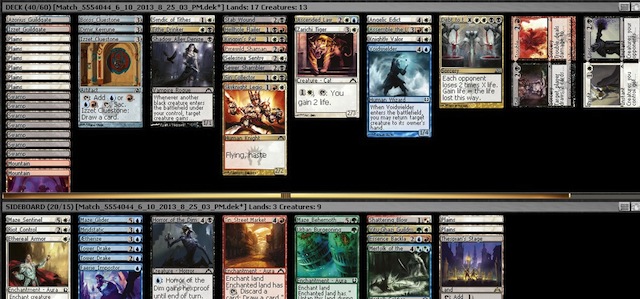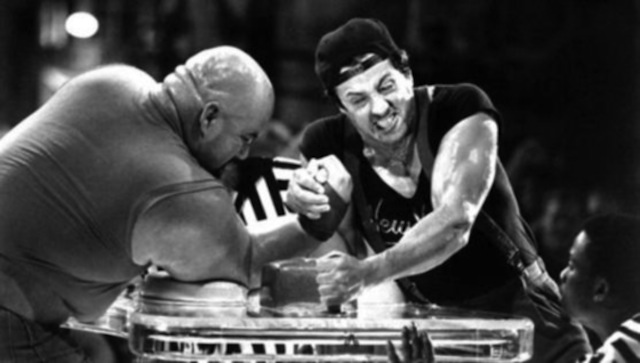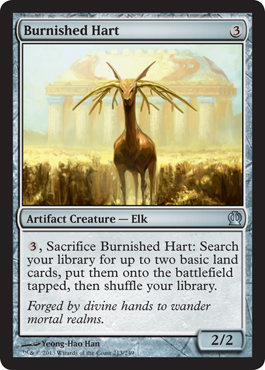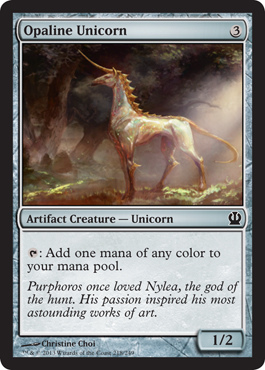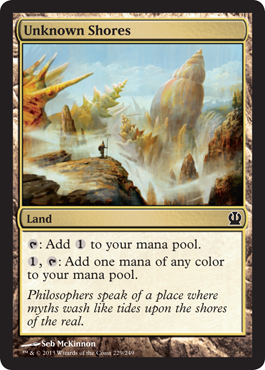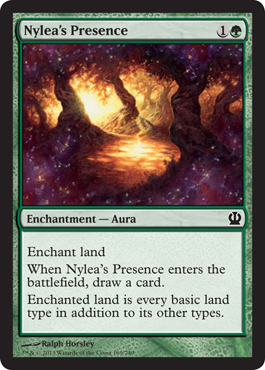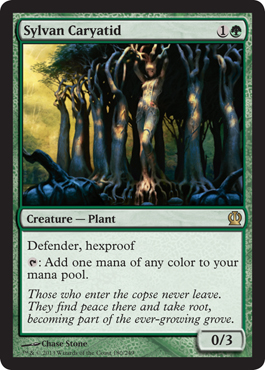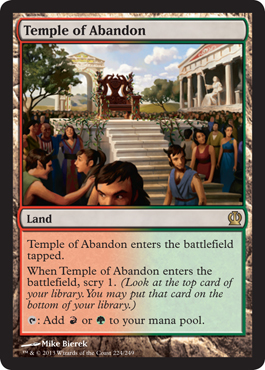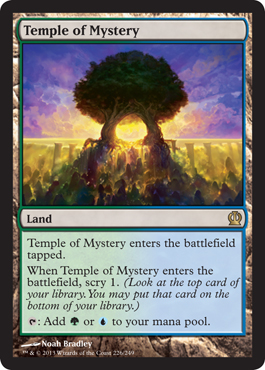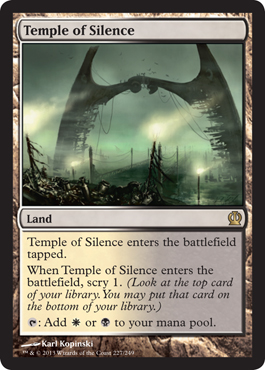The days before the fall set pre-release are a good time to ponder Limited drafting as it varies across sets. This week I am going to talk about splashing extra colors of mana in a Limited deck, and specifically how awesome it is to do that in Return to Ravnica block draft. “Splashing” means playing a small number of cards from a color outside the core of your manabase, and adding mana sources to support the splashed cards.
On Labor Day I got the chance to draft DGR one last time before Theros takes over, and the deck I drafted perfectly demonstrates the various ways to work with splash colors. DGR has been one of my favorite draft formats, so I’d like to send it off in style. I will show you the deck I drafted, Simic with splashes for white and red, and then look at alternate builds from my pool splashing only white or only red.
At the end of the article I will look at the mana fixing available in Theros and give my initial impressions of splashing in Theros Limited.
Limited Deckbuilding
Most Limited decks use two colors of mana. Two-color decks vary from even splits (the old 9/8 or 9/9 split of basic lands) to a heavy focus in one color with a moderate amount of the second color (12/5 or 11/6 manabases). Splashing an extra color throws off the balance in these manabases, so you have to decide if it is worth it. Here are three questions to consider when deciding whether to splash.
1. How powerful are the cards I want to splash?
2. Can I wait until turn seven or later to cast my splash cards?
3. What mana fixing is available?
4. How much will it hurt my main colors if I draw splash mana early instead of core mana?
The first two questions are fairly straightforward and most people think about them when deciding to pick a splash card during a draft. You only want to splash powerful cards, and late game bombs are the best cards to splash. Kalonian Tusker, while a powerful card and quite strong in M14 Limited, is a horrible card to splash. Devout Invocation, on the other hand, is a good card to splash, assuming your deck can keep some creatures on the board.
Would you splash me, foolish fleshbeast?
The third question is helpful to evaluate how well a format supports splashing. If there are three colorless cards that can fix any of your five colors, and at least two of them are common, then it will be easier to splash than if you need to play green or pick up specific cards that produce the color of mana you want to splash. The amount of available fixing tells you not only how easy it will be to splash, but whether Magic R&D intend for splashing to be a regular part of the format. If a set offers a decent selection of efficient mana fixers, that’s a strong hint that R&D wants us to splash. They put cards in the set for a reason. Colorless fixing is more useful, so look out for artifacts that can fix all five colors, or fetch any basic land. Lands that can filter mana into any color, like Shimmering Grotto, or produce all five colors, like Transguild Promenade, also fit in here. Cycles of dual lands are great too, although usually rare.
The fourth question, however, is the most important and most overlooked. The real cost of splashing is not the risk of being stuck with an uncastable bomb in hand while you never draw your splash mana; it is the risk of not drawing enough of your core mana colors and being stuck with three early drops in hand that you never cast because you don’t have two green sources in play. When many of the strong cards in each color require two mana of a color to cast, or require spending a lot of colored mana to activate abilities, the format is going to be hostile to splashing even if there is decent fixing available. Conversely, if most cards require a single colored mana, or one mana of two colors, it will be easier to splash because you can afford to draw only one land for each color.
If you consider M14 as a draft format, you see that splashing is not a great idea. While the format is slow and dominated by powerful cards, there are only five mana fixers: Darksteel Ingot, Shimmering Grotto, Lay of the Land, Verdant Haven, and Manaweft Sliver. Three of those require green as one of your core colors. Shimmering Grotto is not very good, and oddly works better to splash cheap removal than expensive bombs. The only strong fixer available to most decks is Darksteel Ingot, which is uncommon. To make matters worse, many of the powerful cards require two mana of a specific color. Rumbling Baloth, Marauding Maulhorn, Banisher Priest, Water Servant, Liturgy of Blood, etc. And those aren’t even the bombs! As a result, I don’t even think about splashing in M14 draft except in the rarest of circumstances.
Would you splash me, fickle human?
In an M14 draft, I once passed a Primeval Bounty that I opened in pack two because I already had a solid RB sacrifice deck that needed double red and double black. That was probably wrong, because Primeval Bounty is such a powerful and easily splashable card, but I think it is a very close call. In pack three it would have been an easier decision to pass the Bounty. As the first pick in pack two, I probably should have taken the Bounty and looked to switch one of my colors into green. Slow formats usually support splashing, but in M14 it is so important to have multiple mana sources of both your core colors by turn 4 or 5 that I still think that splashing is a bad idea. Even though it is rare to feel pressure before turn four, many decks can kill you by turn seven if you can’t play your double-mana-cost cards.
One Last Return to Ravnica Block Draft
So here’s a format for splashing! I love Return to Ravnica block draft. I love versatility and power. DGR offer both, with split cards, charms, and tons of powerful gold cards. Many people found the format frustrating because it was hard to draft a five color good stuff deck despite the format being full of cards tailor made for such decks. The reality was, you had to focus on one guild or else your deck would implode from its awkward 6-6-5 three color manabase. How do you play all these amazing gold cards if you can only pick from one guild? Splashing, that’s how.
The ideal deck in DGR draft is a two color deck based around one guild that splashes one or two colors to play a handful of powerful bombs. If you can draft an amazing Boros or Gruul deck, then you don’t need to splash. But often you only get 16 playables in your guild. No matter how good those 16 cards are, you still need six or seven more to fill out your deck. If you splash, your options grow tremendously.
The other frustrating part of DGR was finding an open guild. With ten guilds and eight drafters, each person can get a guild to themselves. Sharing a guild with someone else could be devastating. In order to get a guild to yourself, you had two choices: either sit back and read the signals you’re passed or force a Gatecrash Guild in the first pack and cut the drafters to your left from going into that guild.
I think the first option is much better. Unless you open a pack with Ruric Thar and a bunch of powerful Orzhov and Dimir cards to pass, and continue to get passed one good Gruul card per pack in Dragon’s Maze, then you aren’t going to be very sure the person to your left drafts Gruul in the Gatecrash pack. Even then, you are relying on someone else reading your signals and responding rationally. That might work on the Pro Tour, but it is a risky proposition in most drafts.
The magic of reading signals in DGR is that you can stay open in pack one and pick up all the powerful cards from various guilds. If there aren’t any powerful cards, you can grab fixing. If you see a bunch of strong Azorius cards in pack one, you can feel confident Azorius will be open in pack three when you pick Return to Ravnica cards. If a Gatecrash guild is flowing to you in pack one, you can either take a chance on it being open in the other direction or you can keep passing it to encourage someone to your left to take those cards in pack two, leaving other guilds open for you.
I tend to prefer drafting Return to Ravnica guilds anyway (maybe because I liked triple RTR more than triple GTC). One nice benefit to drafting an RTR guild is that you can take fixing highly in pack two. The best card in the format is Prophetic Prism and you want to be able to first pick it in pack two. There are very few bomb rares I would take over Prism, and I won’t get stuck trying to decide between Prism and a power uncommon gold card like Ghor-Clan Rampager if I’m in an RTR guild. You can still pick up bombs to splash in pack two, but you also are free to grab any gates or mono-colored spells that come by. If you pick up a variety of powerful gold cards early in the first two packs, you will have plenty of options to choose when you decide which of these cards to splash. You can also afford to play multiple cluestones on top of 17 lands when the rest of your cards are very powerful. That was the theory I tested with the deck pictured above, months ago, and it worked fine.
The Actual Draft
I started off the draft with Ascended Lawmage, a powerful card in an RTR guild. The next few cards I got were Armed/Dangerous, Beck/Call, and Krasis Incubation. The latter two are a good sign that Azorius is open to my right, as Azorius is likely to want to splash green for the removal spell. In the rest of the pack I picked up cards all over the map, from Dimir Guildgate, Haunter of Nightveil, and Pilfered Plans to two Armored Wolfriders, Steeple Roc, and Deputy of Acquittals. You can always grab a couple on-color cluestones, and I got Simic and Izzet. I think I want to play blue, but my options beyond that are open.
The two best cards I opened in pack two were Aurelia’s Fury and Cloudfin Raptor. I would love to Raptor, but Aurelia’s Fury is incredible, and I could easily end up splashing it in an Azorius deck. If nothing else it is a great finisher even if you can’t reliably cast it early as a removal spell. Second pick I got passed a Prophetic Prism. There is approximately zero chance there’s another card left in the pack that I would take over the Prism. Maybe if I got passed a Domri Rade, which should never happen. After that, I got an incredible run of Simic Cards. It was completely open. Two Drakewing Krasis, Crocanura, Fathom Mage, Frilled Oculus. Then, somehow, the Cloudfin Raptor from pack one wheeled. That was another sign that blue would be open in pack three, and I had to restrain my urge to fist-pump mid-draft. I also picked up a Boros Keyrune and an Agoraphobia. At this point, I am playing Simic, fully expect Azorius to be open pack three, and have a Prism, Boros Keyrune, Simic Keyrune, and Izzet Keyrune to fix my mana. Things are looking good.
Pack three I opened Mizzium Mortars, the ultimate splash test. The other card I wanted to take was Gatecreeper Vine. But why am I taking Gatecreeper Vine if I can’t use it to fetch a mountain and cast Mizzium Mortars? Next came Archon of the Triumvirate, and then I was insanely rewarded for my red splash when I got passed Mercurial Chemister. Hindsight bias is a dangerous thing, but I definitely put myself in position to benefit from a third pick Chemister. From this point, I coasted home with a Voidwielder, Knightly Valor, seventh pick Soulsworn Spirit, and at that point who cares? I suppose if nobody else wanted Cloudfin Raptor they probably didn’t want Soulsworn Spirit either, but that card is very strong and an easy splash.
Here’s what I built:



